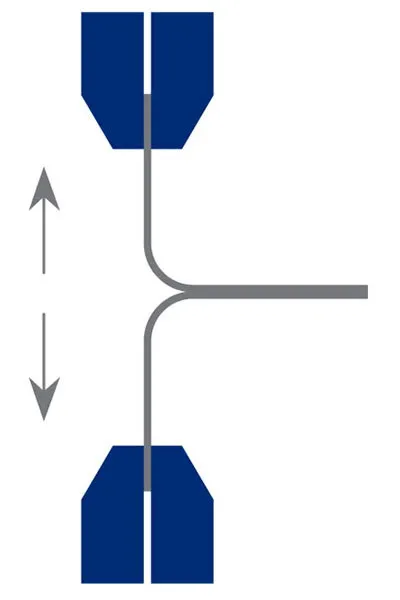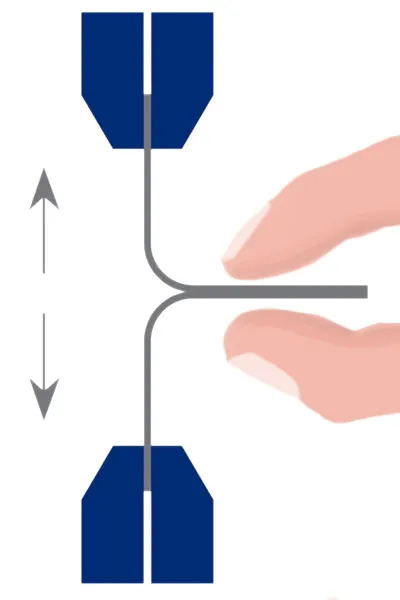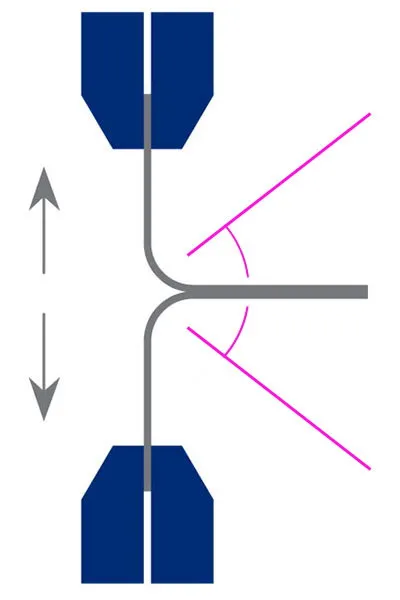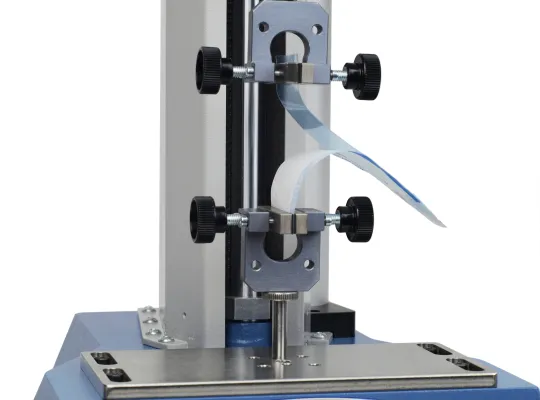Search results
Standards
Featured or equivalent test standards for Mecmesin solutions in this section
Term Video
Test summary
Specimens are cut to a specified width. The seal is then peeled apart by holding the two “legs” of the barrier material in the jaws of a force testing stand set to separate at a constant speed between 200 - 300 mm/min. while the force and displacement are continuously measured. The peak force required to separate the seal is reported, this can also be expressed as peak force per width of the seal material in N/m. Depending upon the characteristics of the specimen, it may also be informative to report the average peeling force over the width of the seal as it separates, discarding the first 10% and the last 10% of the force Vs displacement curve.
Test apparatus
Tensile tester with grips and suitable range loadcell. This may be a vertical testing stand, or alternatively a horizontally oriented instrument
Preparation
Cut a sufficient quantity of strips from a representative sample to a width of 15 mm, 25 mm or 25.4 mm perpendicular to the seal, and 75mm plus the width of the seal in length. If required, condition the specimens in accordance with ASTM E 171
Test method
1. If required, condition the samples as per ASTM E 171.
2. Cut strips from the sample to the dimensions defined in the standard.
3. Clamp the ends of the sample strip into the jaws of the tensile tester with the seal perpendicular to the direction of movement, and equidistant between the fixed and moving jaws.
4. If required, support the tail of the test specimen (see the standard for an explanation).
5. Set the tensile tester in motion at a speed between 200 and 300 mm/min.
6. Record the tensile force and displacement as the seal is peeled apart.
Report
Record all details necessary to identify the sample including width and machine direction in relation to the direction of pull.
Report the speed of separation used by the tensile tester, and the method used to support the tail of the sample if appropriate.
Report the maximum tensile force in newtons encountered as the specimen is stressed to failure. This can also be expressed as force per unit width of the seal in newtons per metre.
Note the method of failure of the seal.
Depending upon the characteristics of the force Vs displacement curve, it may be informative to calculate the average force as the seal is separated, discarding the first and final 10% of the force Vs displacement curve.




Essai de pelage sur pare-brise feuilleté multi-couches pour automobile
Essai de pelage sur pare-brise feuilleté multi-couches pour automobile
Le MultiTest 1-i a été acheté pour tester les propriétés physiques des matières premières et des produits finis. Le capteur de charge 10N est capable de mesurer avec deux décimales, ce qui donne une lecture très sensible et précise, et ce test fonctionne très bien. Le MultiTest 1-i répond à nos besoins et s’est avéré facile à utiliser avec le temps.
Adriana Jamesova,
Salts Healthcare

Afin de respecter les normes britanniques relatives à la résistance du thermoscellage sur les poches médicales, Mecmesin a mis au point un système convivial, affichant les données sous forme graphique, indiquant clairement la conformité à la norme.
David Dixon, technicien en assurance qualité
Rocket Medical Plc


Online test equipment and training demos
As more people are working from home to reduce non-essential travel, our technical sales engineers can provide online equipment demos or training sessions via web-based video calls.
If possible, send in your own samples and our sales team will be able to present your own products being tested.
Get in touch to discuss your requirements and to arrange an online demo or training session.







